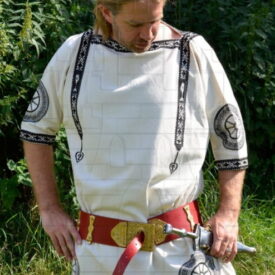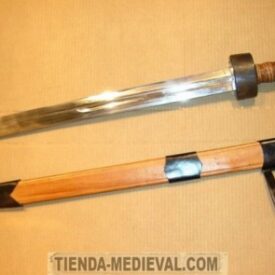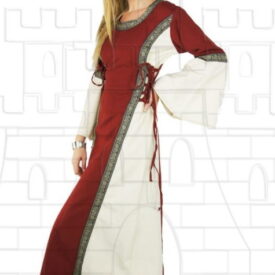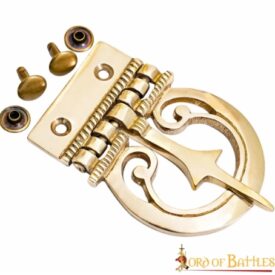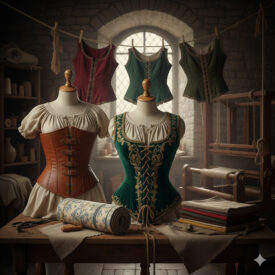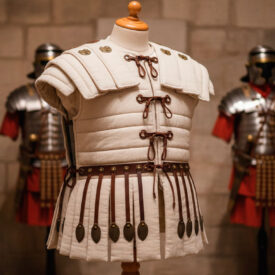What do you see when you imagine the clothing of a Roman citizen? Imagine a piece of cloth that covers the body with simplicity, yet communicates rank, occupation, and tradition: that is the Roman tunic. In this article, we will unravel its origin, its evolution, the materials and colors that made it symbolic, and how to identify its historical variants and modern replicas for recreation or collection.
The Tunic: A Simple Garment with a Complex Language
The tunic is a wide and generally long garment, with or without sleeves, covering from the neck to varying lengths on the legs. Its simplicity is its virtue: a practical form that, with adjustments, stripes, and colors, conveyed the social hierarchy and the wearer’s functions within Roman society.
It was worn by men and women, by citizens and non-citizens, by peasants and patricians: everyone wore it, but with clear differences in cut, length, adornments, and materials. At first glance, a tunic may seem like a shirt; upon observing the details, it reveals announcements about status, military career, and regional customs.
Evolution and Chronology of the Roman Tunic
Placing the chronology here allows us to understand how an essential garment shaped customs, military obligations, and Roman fashion laws. The evolution of the tunic is a direct reading of Rome’s social history: each modification connects with climatic needs, foreign influences, or political changes.
| Era | Event |
|---|---|
| Early Roman Times (Monarchy / Early Republic) | |
| Fundamental Garment | The tunic (similar to the Greek chiton) and the toga were the main garments; the tunic was originally simple, often sleeveless, sewn at the sides and shoulders. |
| Inner and Outer Use | Initially used as an undergarment (indutus/indumenta) and later also as an outer garment (amictus). Later, it became common to wear two superimposed tunics: subucula (inner, often linen) and an outer wool one. |
| Length | Generally reached the calf; the common classes and slaves wore it shorter, to the knee. |
| Late Republic / Early Empire | |
| Talares Tunics | Talares tunics appear, longer to the heels and longer in front than in back. |
| Prejudices and Norms | There was prejudice against sleeves for men; it was also incorrect to dress without a belt (cingulum). |
| Social Distinctions (clavi) | The tunic was adorned with purple bands (clavi) to indicate rank:
|
| 58 BCE | As a sign of protest during the attempt to exile Cicero, the senators wore the angusticlavia. |
| Late 1st Century CE (Roman Empire) | |
| Introduction of Sleeves and Variants | The tunic with sleeves (manicata) is adopted. Specific forms emerge such as the exomis (wide, without the right shoulder) used by slaves and shepherds. The use of bracae (trousers) begins to spread, imitating northern peoples. |
| 2nd–3rd Centuries CE (Military Evolution and Crisis) | |
| 2nd Century CE | Auxiliary cavalry troops already wore long-sleeved tunics and trousers from the 1st or at least the 2nd century. A papyrus from 138 CE describes a short-sleeved legionary tunic, consistent with sculptural representations of the period. |
| 3rd Century CE | Marked expansion of new styles in the military sphere: legionaries, traditionally with short-sleeved tunics, begin to wear long-sleeved tunics (tunica manicata), influenced by auxiliary troops, mercenaries, and climatic necessity. The dalmatica is fully integrated into the military establishment and adopted by emperors. |
| Caracalla (early 3rd century) | Emperor Caracalla popularizes garments of Germanic origin: he wears decorated long-sleeved tunics and is attributed with the spread of the caracallus, a long hooded cloak. |
| Late Antiquity and Post‑Imperial Period | |
| Early 4th Century | The mosaics of the Villa Romana del Casale show men dressed in the tunica manicata, indicating the generalization of long sleeves. |
| End of the Empire | The tunica manicata (long sleeves, vibrant colors, and ornamental patterns) becomes popular, disappearing the republican prejudice against long sleeves in men. |
| Later Use | The Church adopts the tunic and the dalmatica tunic as liturgical vestments, perpetuating these forms in the post‑imperial period. |
Materials, Dyes, and Techniques: The Vocabulary of Fabric
 Roman tunics were made from materials ranging from wool and linen to silk in exceptional cases. The choice of fabric was not just practical: it was a visual announcement of the wearer’s financial standing. Wool was the basis of most garments; linen and silk were luxuries for those who could afford them.
Roman tunics were made from materials ranging from wool and linen to silk in exceptional cases. The choice of fabric was not just practical: it was a visual announcement of the wearer’s financial standing. Wool was the basis of most garments; linen and silk were luxuries for those who could afford them.
Dyes were equally significant. Tyrian purple, extracted from the mucus of certain mollusks, was the emblem of power. Not everyone could afford it; that’s why purple stripes (clavi) became a visual shortcut to signal rank without weaving an entire tunic of that color. Other dyes — ochres, reds, and brown tones — were obtained from roots, insects, and minerals.
How a Tunic Was Made
The most primitive construction consisted of two pieces of fabric sewn laterally, leaving openings for the head and arms. Over time, more refined patterns emerged, with sewn sleeves, pleats, and adornments. A belt (cingulum) transformed the piece: cinched at the waist, it made the wearer more functional; crossed and loose, it could indicate a style or class preference.
Men, Women, and Length as Code
One of the clearest distinctions between men’s and women’s tunics was length. Men usually wore shorter tunics, knee-length, which facilitated movement in daily tasks or combat. Women wore talares tunics, which reached their ankles and allowed for additional layers like the stola.
In addition to length, the finishes on the neck and cuffs, embroidery, and accessories marked differences. High-ranking women wore richer decorations and finer fabrics; working classes opted for functionality and durable fabrics.
The Tunic in the Army: Function and Myth
The relationship between the tunic and the legion is one of the most persistent debates among historians: were legionaries dressed in red to instill fear, or did they wear undyed garments for economy? The truth is that the military tunic served a practical function as an inner layer, protection, and comfort under armor.
It is possible that officers and commanders wore red-dyed garments as a sign of distinction, while the basic troops used simpler colors. The adoption of long sleeves in the army responded to climatic factors and contact with auxiliary troops from cold regions.
Military Variants and Their Purpose
-
Exomis: short tunic with one shoulder exposed, comfortable for manual labor and physical tasks.
-
Manicata: long-sleeved tunic, adopted by legionaries in cold climates and by auxiliaries.
-
Dalmatica: of Dalmatian origin, with sleeves, integrated into late military and civilian attire.
Types of Tunics: Comparative Table
| Type | Usual Length | Characteristics | Typical Use |
|---|---|---|---|
| Exomis | Short (hip-length) | One shoulder exposed, sleeveless on one side | Physical labor, slaves, shepherds |
| Laticlavia | Knee-length or longer | Wide vertical purple band, senatorial symbol | Senators and high officials |
| Angusticlavia | Knee-length | Narrow purple band, equites | Equestrian class and magistrates |
| Manicata | Varies | Long sleeves, warmth | Auxiliaries, troops in cold zones |
| Tunica talaris / Stola | Long, ankle-length | Pleats and decorations for women | Women, formal occasions |
Roman Tunics and Available Replicas
For those who recreate, collect, or simply wish to understand how to live and feel history, current replicas seek to balance historical accuracy and practical use. When evaluating a replica, observe the cut, materials, seams, and, above all, the presence or absence of adornments that indicate status.
Almost all replicas are inspired by museum pieces and iconography: mosaics, reliefs, and literary descriptions. When a replica incorporates clavi, purple, or elaborate embroidery, it makes a historical statement about who would have worn it.
When choosing a tunic for recreation, consider:
- Material: wool for authentic appearance and warmth, linen for summer scenes or interiors.
- Cut: long for women (talaris), shorter for men or for labor.
- Details: clavi, embroidery, and seam quality as an indicator of fidelity.
The Symbolism of Color and Decoration
The color of a tunic was not arbitrary. Purple and its nuances represented power and access to exclusive resources. Bright tones and fine fabrics were the heritage of those who could afford expensive dyes. In contrast, the natural shades of raw wool or ocher and brown tones were typical of day laborers and workers.
Vertical stripes (clavi) were an effective symbolic solution: with just one stripe, belonging to a class was declared. Later, embroidery and prints became common among the late elites who wanted to emphasize position and wealth.
Textile Production: Workshop, Techniques, and Craft
 The weaving and sewing of tunics were artisanal tasks. In the workshops, spinning, dyeing, and sewing took place: each step determined the durability and final appearance. Dyers specializing in purple enjoyed great prestige; spinners and weavers, for their ability to create uniform and durable fabrics.
The weaving and sewing of tunics were artisanal tasks. In the workshops, spinning, dyeing, and sewing took place: each step determined the durability and final appearance. Dyers specializing in purple enjoyed great prestige; spinners and weavers, for their ability to create uniform and durable fabrics.
Seams and Patterns That Speak
Observing how a tunic is sewn tells you a lot. Simple and functional seams imply an everyday garment. Reinforced and decorative seams, along with attention to finishes, indicate an economic investment and, therefore, higher status.
The Tunic Beyond Rome: Survival in the Middle Ages
After the fall of the Empire, the tunic did not disappear; it evolved. In the Middle Ages, it served as the basis for new garments such as shirts, blouses, and hose. Variations in length and sleeves continued, adapting to climates, functions, and regional styles.
In Anglo-Saxon and continental regions, tunics were decorated at the neck and cuffs. The accessibility of fabrics and dyes dictated marked differences between rich and poor, but the basic form of the tunic persisted as a functional and comfortable garment.
How to Read a Historical Tunic: Practical Guide
If you have a tunic or a replica in front of you and want to know what it tells, follow this order:
-
Material: wool or linen indicate functional authenticity; silks and fine fabrics, high status.
-
Length: short=active or masculine use; long=feminine use or ceremony.
-
Decoration: clavi and embroidery indicate rank; absence, a work garment.
-
Seams: simple seams vs. reinforced finishes; the latter indicates investment and better artisanal skill.
Care and Maintenance for Replicas
 If you own a wool replica, wash with cold water and dry in the shade to preserve shape and color. Avoid harsh detergents and high-temperature ironing. For dyed canvases, first test in an inconspicuous area to check dye fastness.
If you own a wool replica, wash with cold water and dry in the shade to preserve shape and color. Avoid harsh detergents and high-temperature ironing. For dyed canvases, first test in an inconspicuous area to check dye fastness.
Questions the Tunic Still Raises Today
Was the tunic a social unifier or a device of segregation? The answer lies in its duality: a garment shared by all, personalized by details that divided status. How to adapt that language to recreations? With attention to historical context and fidelity in materials and adornments.
Today the tunic continues to speak. It speaks of textile ingenuity, social structures, and how a piece of cloth can become an emblem. For the enthusiast, understanding that language allows for recreation with respect and precision.
Practical Ideas for Reenactors and Collectors
If you participate in historical reenactments, prioritize authenticity where it is crucial: materials, color, and cut. For static display, decorative details gain more weight. For practical use in events, seek a balance between fidelity and comfort.
- Campaign reenactment: durable wool, cuts that allow movement.
- Summer event: light linen and natural colors.
- Elite representation: pay attention to clavi, embroidery, and the use of rich dyes.
Final Reading and Call to Observation
The Roman tunic is an everyday object that summarizes centuries of customs, economy, and aesthetics. Looking at it is reading a page of Roman social history. Observe the fabric, length, and details: each element is a clue about who wore it and why.
If you are interested in delving deeper, examine ancient images, reliefs, and mosaics; compare with replicas and ask yourself what message each variation attempts to convey. History is woven into the fabric: you just have to learn to decipher it.


